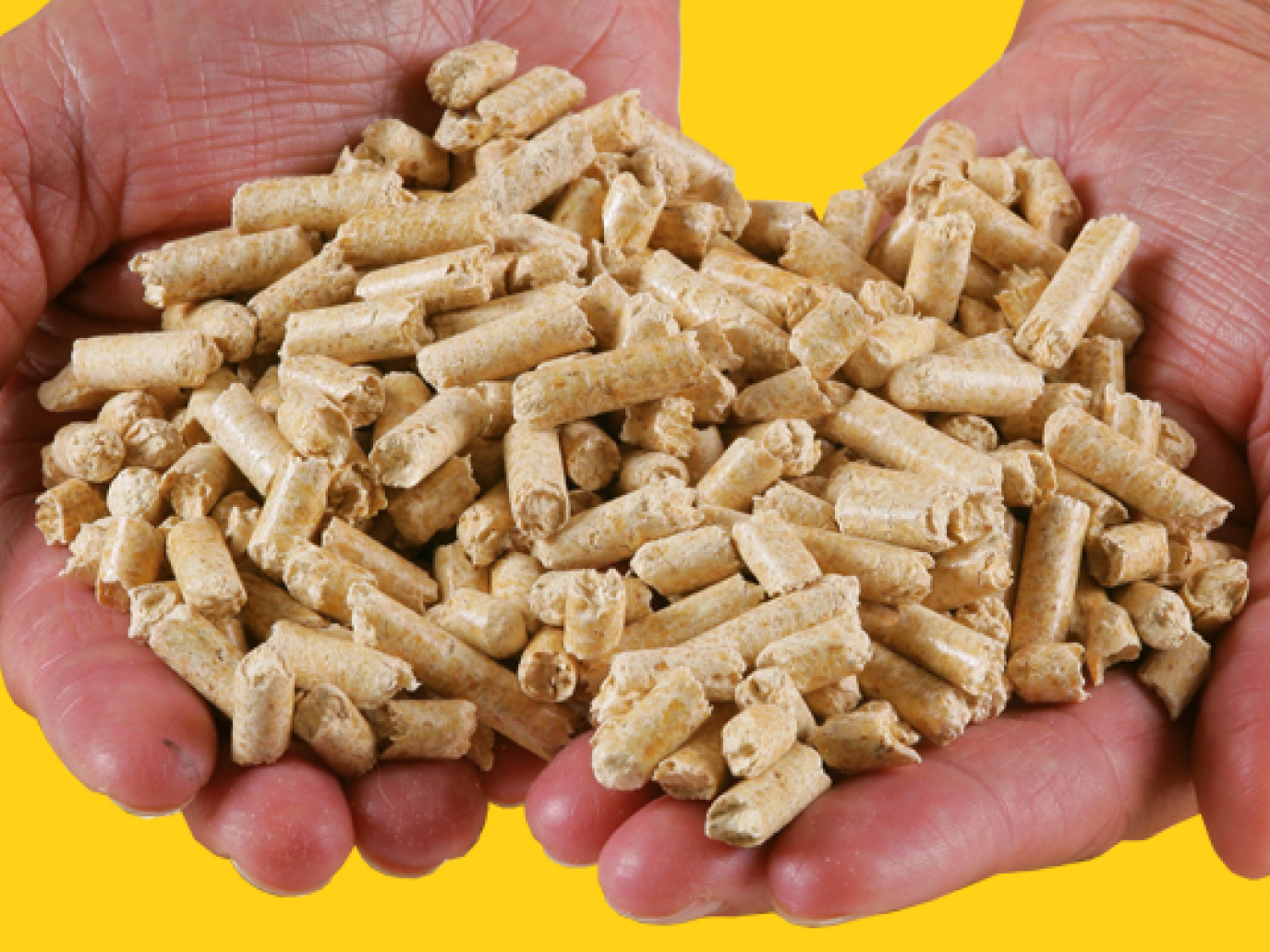The availability of biomass is the bioeconomy’s lifeblood. Being able to predict flows becomes strategic for government and the industrial sector. Lately there has been a proliferation of analyses attempting to estimate how supply and demand will be modified over the years. According to a study by the University of Wageningen (The Netherlands), if by 2020 20% of chemical products and oil-based products were replaced by bioproducts, 34 MMT (million metric tons) of biomass would be necessary. By 2030, 30% would need at least 50 MMT. To give you an idea of what we are talking about, today the biomass used in the European Union is about 1 MMT.
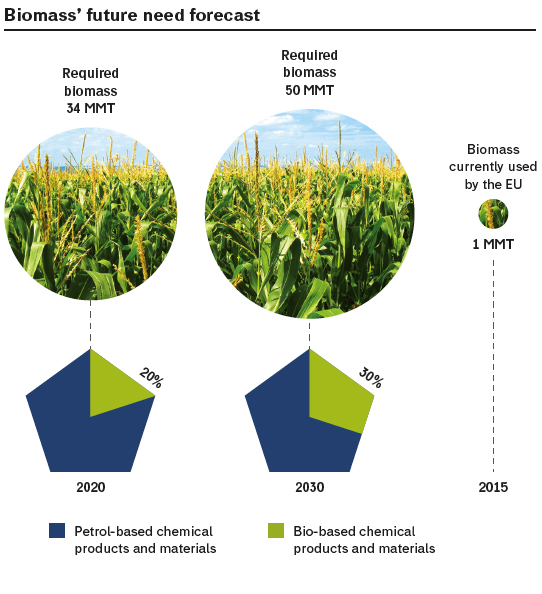
The nova-Institute (Germany), in Bio-based Polymers in the World estimates that the production of polymers in the Union is bound to grow from the current 320,000 MT to about 1.2 MMT in 2020, thanks to the driving force of starch mixtures, PET and PLA. The Plant PET Technology Collaborative (PTC), signed in October 2012 by Coca-Cola, Heinz, Ford, Nike and Procter & Gamble with an aim to reach as soon as possible the target of 100% biobased PET for their products, is also a step in the right direction.
But the growing demand of biomass in Europe will scarcely be able to be met by local supply. So, imports rule, which undermine environmental sustainability. In this regard, Versalis plan to reconvert Gela’s refinery in Sicily by using palm oil from Malaysia gave rise to a heated debate.
The issues of biomass include logistical problems, which countries such as Belgium and Holland intend to solve thanks to their ports of Ghent and Rotterdam, situated in the vicinity of an industrial area with a strong agricultural and chemical propensity. The chemical industry in the Netherlands, pushed by the abolition of sugar quotas scheduled for 2017 by the new Common Agricultural Policy (CAP), planned a €1 billion investment in infrastructure and services for the conversion of sugar beet in biobased chemical products. AkzoNobel joined forces with SuikerUnie, Rabobank, an agency for investment and development in North Holland, Groningen Province and its sea ports to study the possibility to produce chemicals from raw materials derived from sugar beet. At Deloitte, a feasibility study on the commercial production of various kinds of biochemicals in the chemical cluster in Delfzijl is being carried out. The results of the Deloitte’s analysis will be available before summer 2015.
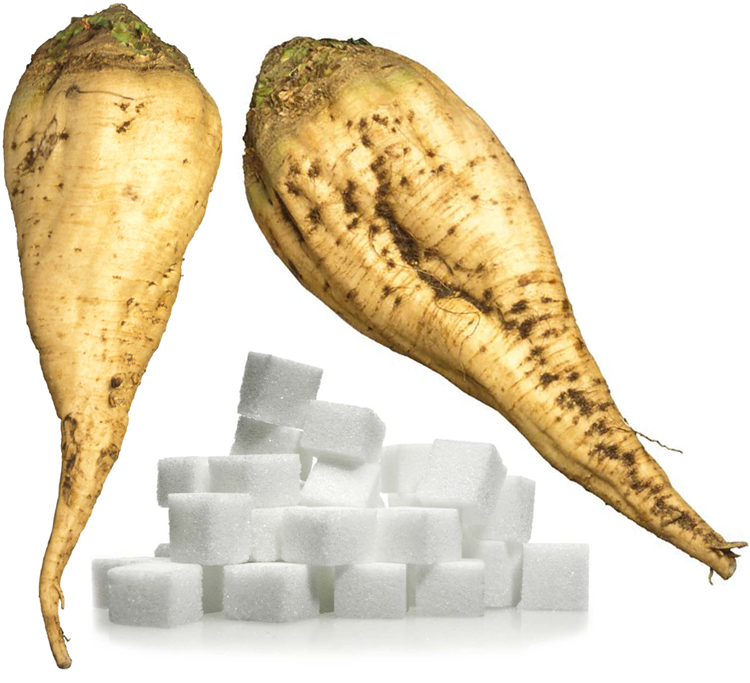
As for biofuels, today the European Union relies heavily on biomass imports, mainly from the United States. Indeed, in 2014, 3.8 MMT of wood pellets have come from across the pond (worth $730 million) and about 170,000 tons of used oils and fats ($150 million). Considering the targets set for biofuels and renewable energy and the objectives to replace oil-based chemical products and materials, it is very likely that the Union will have to rely even more on biomass imports from third-party countries.
The Netherlands Enterprise Agency, a Dutch government agency, estimates that 90% of 3.5 MMT of pellets necessary for the country will have to be imported from abroad, mainly from countries outside Europe. So, the agency has started a programme – Biologik NL – to establish which logistics structure would be most suitable to ship such biomass form the producing countries to Dutch manufacturers.
However, according to the US analysis, the availability of biomass in Europe is threatened by restrictive sustainability needs that are unable to acknowledge sustainability practices in other countries. Corn imports for the production of bioethanol is limited by sustainability requirements set by the EU directive on renewable energy. Such directive – claims the US Department of Agriculture – is also limiting the imports of soybean seeds for the production of biodiesel. If such approach is also applied to biomass – the US Department of Agriculture says – Europe could undermine the supply of pellets from North America.
So, it is increasingly obvious that the final game of the European bioeconomy and its sustainability will be played in Brussels. But it is also obvious that the ability of the single member states to influence European policies and to define which model to adopt is directly proportional to their ability to have a strategic national plan. In this respect, while countries of Northern Europe have all adopted a strategy and rely on team work (first of all Belgium, the Netherlands and Germany), Southern Europe – with Italy in the lead – is still miserably dormant.
 |
|
©UPM |
Interview with Marko Janhunen, Vice President UPM Biorefining
There is a Substantial Untapped Resource of Unused Cellulosic Wastes and Residues Sustainably Available in Europe
As the frontrunner of the new forest industry, UPM – the Finnish pulp and paper giant, whose sales totalled 9.9 billion euro in 2014 – leads the integration of bio and forest industries into a new, sustainable and innovation-driven future. Fibre- and biomass-based businesses, recyclable raw materials and products are cornerstones of UPM’s business. Biofuels are a topical example of UPM’s innovation work, with the renewable diesel biorefinery in Lappeenranta. Other new businesses include biocomposites, which are already being marketed to customers, as well as biochemicals and biofibrils, which are currently in the development phase.
With Marko Janhunen, Vice President Stakeholder Relations at UPM Biorefining, we talk about the bioeconomy and the related future of the pulp and paper industry.
What is the vision that drives a pulp and paper giant like UPM to invest in the use of biological resources to produce bioproducts?
UPM has been active in the forest industry for over one hundred years. We have always believed that products made from renewable raw materials have fantastic environmental credentials. UPM has a turnover of approximately 10 billion euro. Almost all of our products, such as paper, pulp, timber, plywood, and labels are based on wood. We are also a major producer of biomass based renewable energy.
Sustainable forest management and ensuring sustainability with various chain of custody systems and certificates is the corner stone of our operations.
We recognize that key global drivers such as climate change and resources scarcity will create new opportunities for renewable raw materials. This is why we have invested in advanced biofuels which come from non-food chain raw materials, have high GHG saving and are of high quality. We are investigating all the time new opportunities and technologies to develop biofuels, biochemicals and biocomposites.
 UPM has created Biofore term to describe new forestry industry. But what is exactly your Biofore Strategy?
UPM has created Biofore term to describe new forestry industry. But what is exactly your Biofore Strategy?
Biofore highlights our heritage as forest industry company and combines that with new innovations, opportunities and even new sectors. Today we are increasingly developing our innovations in collaboration with the petrochemical and chemical sectors from different countries. Advanced biofuels is currently our spearhead project. In addition, UPM is investing a lot in developing new wood-based products, such as biochemical and biocomposites.
At what stage is the wood-based liquid biofuel developed by UPM?
We are operational. UPM’s Lappeenranta Biorefinery started up in January this year. We started developing the wood-based biofuels platform in 2006 and made the investment decision in 2012.
In Lappeenranta we produce 100,000 tons or approximately 120 million litres of renewable diesel per year. This corresponds with average yearly consumption of 100,000 cars. We are therefore not talking about demo-size. This is really a Commercial Scale plant which was just awarded as the Commercial Scale Plant of the Year in WMB Bio Business Awards 2015.
In the last seven months, the barrel of oil has lost more than half of its value. If last summer prices exceeded $110, now approaching 40. Is this changing the investment choices of UPM in bioproducts?
It would be too short-sighted to consider investments from the point of current oil price. While oil price has come down, the price of vegetable oils, which is also relevant to us, has not. And while oil is cheap at the moment, we see energy security and energy independence growing strongly in importance. We believe that there are important economic, social and environmental drivers promoting advanced biofuels at the moment and in long term.
The availability of biomass is crucial to the development of the bioeconomy. Do you agree with nova-Institut in Cologne, according to which there is an improper allocation of biomass available in Europe to promote biofuels instead of biochemicals?
I believe we have raw materials and opportunities in both sectors. According to a recent ICCT report – “Wasted” – there is a substantial untapped resource of unused cellulosic wastes and residues sustainably available in Europe. That could substitute up to 16% of European road transport fuel by 2030 while delivering greenhouse gas savings of 60% or more.
I see for example UPM’s Lappeenranta Biorefinery as a stepping stone in to using our own pulp making residue but also various other sustainable raw materials, and also eventually moving in the direction of biochemicals. This is already the case in most second generation ethanol plants.
If you consider our Lappeenranta investment, we have developed innovations that enable us to increase the added-value of crude tall oil which is a residue from our own pulp production. We produce renewable diesel that reduces GHG emissions by up to 80% compared with fossil diesel. Similar innovations are possible at large forest industry integrates, and other industries.
Bioeconomy development requires big, bold steps. Our Lappeenranta biorefinery is a good example combining forest and bio industry. We need to create framework considerations for sizeable investments.
According to McKinsey by 2020 global demand for biobased products could grow to 250 billion euros. How can European industry be ready to face this challenge?
Europe is still today leader in renewable energy development. The Energy Union communication by the European Commission states that the EU wants to keep that position.
I am certain that the industry is ready. The question is do we have such regulatory long-term visibility that enables investments? At the moment we do not. Politicians would need to propose post 2020 policy the soonest possible in order to enable investments to move forward.
What’s the role of bioeconomy for the future of a reality such as UPM? And for the sustainability of the industry?
Bioeconomy is a great opportunity for European industry. If you look for example at advanced biofuels, we use domestic raw materials, we operate in rural areas, we utilize European technologies, and we reduce our energy dependency on outside EU oil reserves. That is a great story.
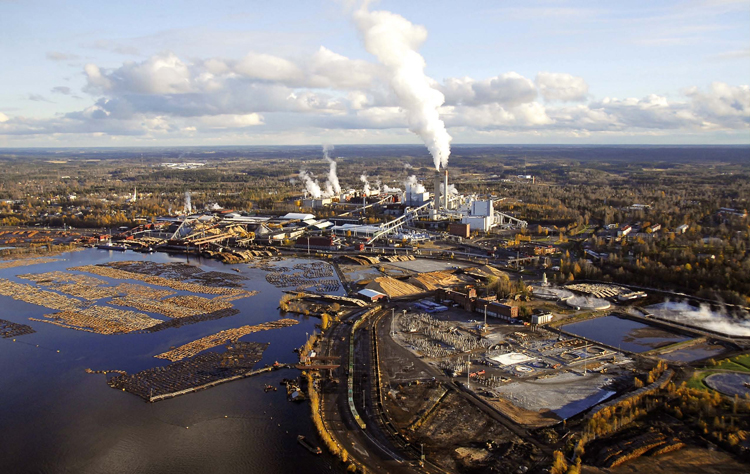 |
|
The UPM biorefinery in Lappeenranta acts as a springboard for using pulp waste as well as other raw materials to produce biochemicals - ©UPM |
From your point of view, will it be possible for the industry to meet sustainability goals and yet be competitive?
In this business sustainability is imbedded into everything. In advanced biofuels sector, the foundations of the industry are in the need to reduce GHG emissions in the transport sector sustainably. With technological development, increased usage of innovative and sustainable feedstock, and increased number of plants operating the competitiveness of the sector will be improved.
European bioeconomy stakeholders complain of a lack of regulatory stability in Europe and move investments to other countries. From your point of view, what should the EU do to create a more favorable environment for industrial investments in the bioeconomy?
The most important thing, looking from advanced biofuels sector point of view, is to propose EU policy on reduction of emissions in the transport sector and the dedicated role of advanced biofuels in this context. An example would be a binding target for advanced biofuels in Renewable Energy Directive, and continuation of such advanced biofuels mandate post 2020.
 |
|
©Clariant |
Interview with Paolo Corvo, Head of Business Development, Biofuels & Derivatives at Clariant
The Biofuel Challenge
Sustainability and innovation. These are strategic pillars of the business strategy of Clariant, one of the world’s leading specialty chemical companies. With its Group Biotechnology based in Germany, Clariant has developed the sunliquid® process for the sustainable production of cellulosic ethanol and biochemicals from agricultural residues. Process and feedstock specific enzymes, which are produced during the process, hydrolyze residues such as straw, bagasse, or corn stover. The following fermentation of all sugars to ethanol combined with an energy saving separation technology result in a competitive and sustainable process. In this interview with Paolo Corvo, Head of Business Development, Biofuels & Derivatives, we talk about the vision that drives a chemical giant to invest in the use of biological resources, the availability of biomass to produce biochemicals, the impact of the volatility of oil price on the bioeconomy and more generally the future of the chemical industry.
Mr Corvo, what is the vision that drives a chemical giant like Clariant to invest in the use of biological resources to produce (bio)chemicals?
As one of the world’s leading specialty chemical companies, Clariant contributes to value creation with innovative and sustainable solutions for customers from many industries. Sustainability and innovation are strategic pillars of Clariant’s business strategy: We need to look for innovations to increase energy and process efficiency as well as foster the substitution of fossil resources with renewable ones to remain competitive in the long term. Along with this comes an increased demand for more sustainability from the market side. An increasing share of raw materials we use is renewable, so Clariant is well on track.
In our research efforts sustainability is closely linked to innovation. Industrial biotechnology has been recognized as a key enabling technology to address the challenges we are facing today. Clariant’s Group Biotechnology revolves entirely around industrial biotechnology. Focus is the development of processes and products from renewable resources. It has set itself the goal of efficient and sparing use of natural resources. Sustainability is regarded an all-embracing concept – ecological, economic and social.
A good example is our sunliquid® technology platform. Our process technology uses agricultural residues such as wheat straw or bagasse to produce biobased chemicals or cellulosic ethanol that can be used as an advanced biofuel, with highest greenhouse gas savings and no land-use competition.
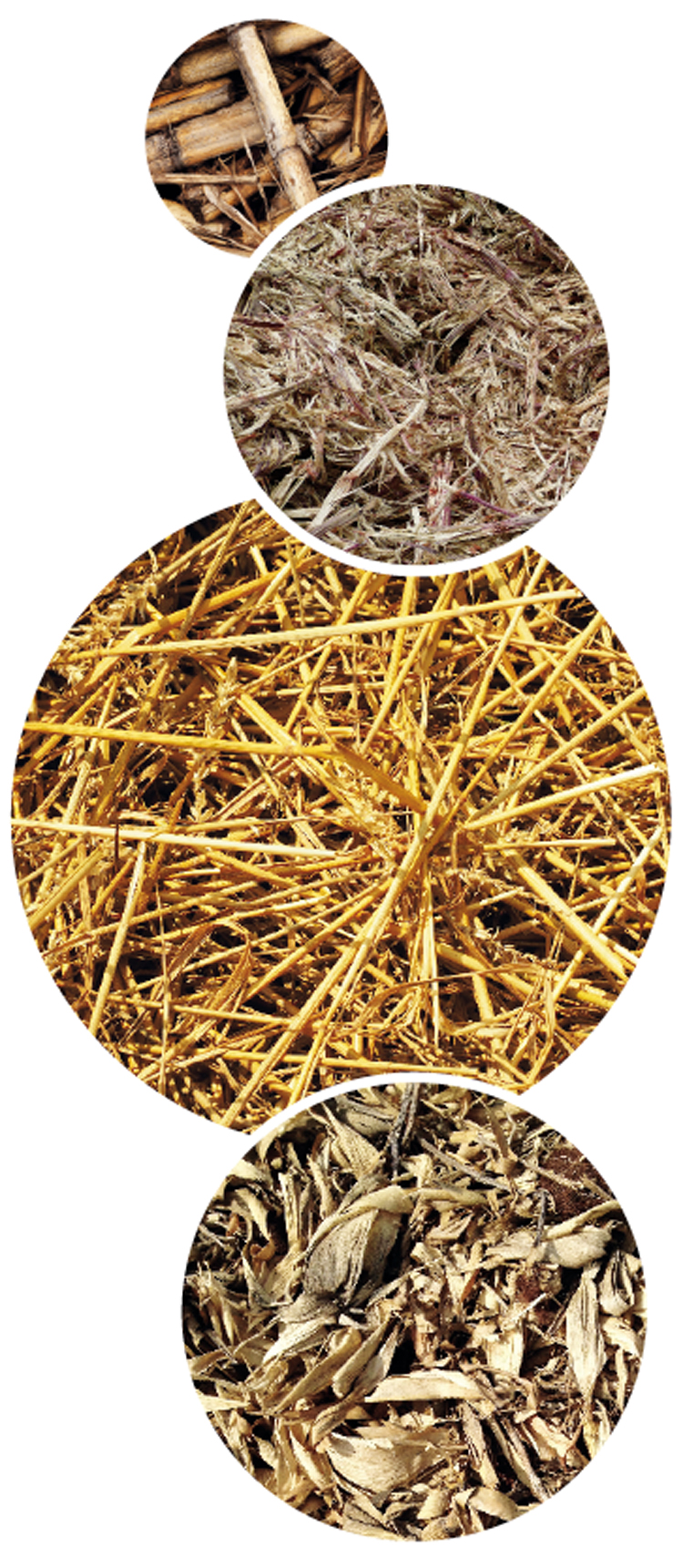 What is the innovative power of the sunliquid® platform and at what stage is the second-generation technology developed by Clariant?
What is the innovative power of the sunliquid® platform and at what stage is the second-generation technology developed by Clariant?
The sunliquid® platform uses innovative biotechnological processes to access the sugars bound in cellulose and hemicellulose for the production of advanced biofuels and biobased chemicals. Highly optimized feedstock and process specific enzymes break down the stable polymer structure and convert it into fermentable sugars in high yields. These enzymes are being produced process integrated from the cellulosic material itself, which results in lowest enzyme costs as it eliminates additional formulation and transportation. This combination solves the challenges of enzyme supply and cost and makes plant operators independent from external suppliers.
In the next step, an optimized fermentation organism simultaneously converts C5 and C6 sugars into cellulosic ethanol, increasing ethanol output by approximately 50%. Energy efficient ethanol separation and thorough energy integration have succeeded in an entirely energy self-sufficient process: all energy demand can be generated from the non-fermentable side streams mainly lignin. No fossil-based energy sources are used. Thus making the sunliquid® process almost carbon neutral with greenhouse gas savings of about 95%.
In July 2012, Clariant brought a sunliquid® demonstration plant online in Straubing, Germany, confirming that the technology works on an industrial scale and on various feedstocks within established and well characterized equipment. A unique approach in the industry, significantly reducing the up-scaling risk involved in implementing this innovative technology.
Today, Clariant has transitioned from technology development into commercialization of its entirely integrated sunliquid® process and developed a technological blueprint for commercial scale plants at competitive production costs for its customers worldwide. The modular design offers a flexibility that makes it easy to adapt the sunliquid® process to meet specific project, feedstock and site specific requirements geared to the customer’s needs.
And flexibility of the technology goes even further: sunliquid® allows for conversion of agricultural residues into a range of chemicals for different industries and applications.
You have recently finished a fleet test in collaboration with Mercedes-Benz and Haltermann with a second generation sunliquid®20 fuel. What were the results?
The fleet test shows that cellulosic ethanol is not merely a dream of the future but can be applied in today’s fleet so that drivers could already benefit from its superior performance and sustainability.
The test results have far exceeded our expectations. First of all, the test vehicles, which are all Mercedes-Benz series vehicles that were not modified for this test in any way, have demonstrated highest performance of fuel and engines. We have found that due to its first-class combustion properties, sunliquid®20 – a premium-grade gasoline containing 20% cellulosic ethanol – improves engine efficiency, so that its 4% lesser energy content, as compared to E10, is more than compensated for. Moreover, particle emissions are reduced by 50% compared to the EU reference fuel EU5. In comparison to fossil fuels, sunliquid® cellulosic ethanol saves around 95% greenhouse gas emissions, without being in competition with food- and feed production. For drivers this means: superior sustainability combined with highest technical performance. Without compromising range and driving comfort or making any adjustments to the gas station infrastructure in Europe, consumers could already fill their tanks with this eco-friendly fuel.
 |
|
©Clariant |
In the last seven months, the barrel of oil has lost more than half of its value. How does this impact your activities?
Currently we see a more volatile oil price than we did the last years, but we believe that in the mid to long-term, oil prices will revert their current trend. With an ever growing population and increased industrialization in developing countries, the population’s need for food, energy, fuels, chemicals and materials will continue to grow. The challenge we are facing is to fulfill these needs with a limited amount of resources while at the same time preserving our environment and increasing quality of life. Tackling these challenges has led to an overall understanding that renewable resources will have to play an ever increasing role in our daily lives and many governments have set ambitious targets to foster the development and implementation of innovative technologies to make these resources accessible for use.
For example the renewable energy directive and the fuel quality directive that mandate an increase in the use of biofuels is actually creating additional interest from mineral oil companies and mandated parties which are looking at advanced biofuels as a valid additive to their core product.
Also the demand for biobased chemicals is not exclusively driven by the oil price – the demand of customers for more sustainable solutions and new, innovative properties is generating an increasing market pull.
In the end, we will need a stable and secure supply of energy, chemicals and materials that will live up to the demand of a rising population. To achieve this, we will use all resources in the most efficient way. Thus, the biobased industry will play a substantial role in providing sustainable solutions and business plans that are based on leading competitive technologies such as sunliquid® will deliver the expected return on investment.
What kind of biomass do you use to produce your bio-products?
The sunliquid® process is entirely based on lignocellulosic resources, such as agricultural residues. These resources do not compete with food and feed crops, but are created in vast quantities worldwide as a by-product of current agricultural practices, as in the case of straw from cereal production. A large fraction of it is currently unused thus available for the conversion into advanced biofuels and chemicals.
Through our proprietary feedstock and process specific enzymes, we are able to adjust our sunliquid® process to the most varied types of feedstock within a short time, including cereal straw, corn stover, bagasse, or energy crops such as miscanthus and switchgrass. We have successfully proven performance of our processes on wheat-straw, corn stover and bagasse at our demonstration plant in Staubing showing excellent results. A number of other lignocellulosic feedstock has shown good performance at pilot and lab scale.
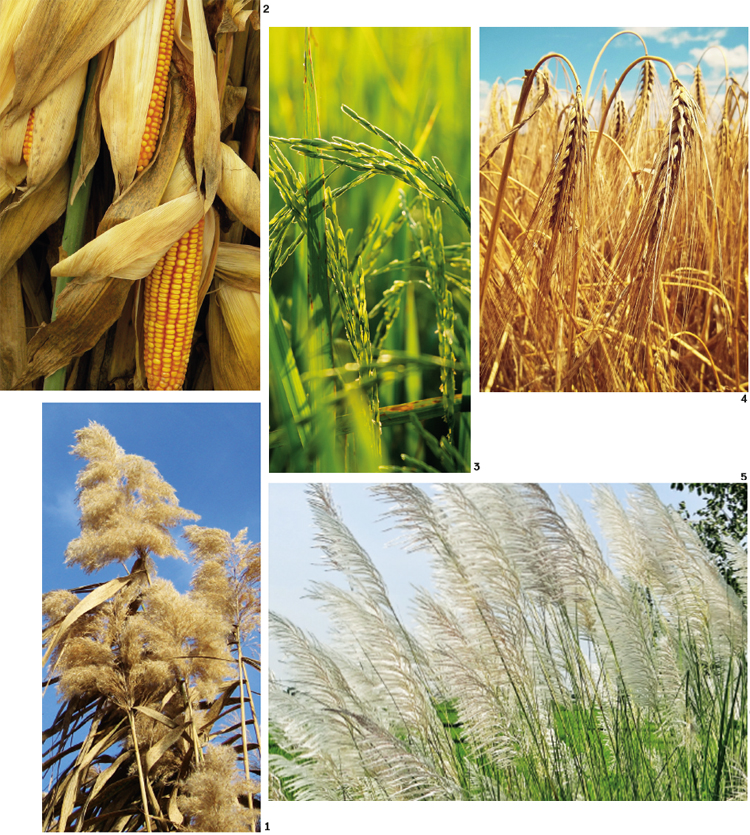 |
|
The agricultural residues of these raw materials can be used to produce biochemicals: |
Do you agree with nova-Institute in Cologne, according to which there is an improper allocation of biomass available in Europe to promote biofuels instead of biochemicals?
We do not see the contradiction between the business sectors. In a biorefinery, as in current oil based refineries, the number of products that can be produced varies from energy and biofuels to biobased chemicals and even specialties.
Looking at our sunliquid® technology for instance, we created a technology platform that is able to supply both, fuels and chemicals: cellulosic ethanol as well as biobased bulk chemicals such as organic acids or specialties, e.g. enzymes from agricultural residues as a feedstock, while at the same time supplying needed energy from its non-fermentable byproducts. We believe that fuels and chemicals go hand in hand and the development of one supports the other. Sunliquid® is an excellent example showcasing the huge potential of biobased processes and the biobased economy.
However, we do see a conflict in the use of biomasses for highly subsidized electricity production. First, it’s technically highly inefficient to simply burn sugars in the form of cellulose to produce electricity, which can also be produced from wind and solar, wasting sugars as a natural resource for high energy density liquid fuels and chemicals. Second, exceedingly high feed in tariffs in the electricity market may critically distort the market economically, essentially slowing down transition to renewables.
According to McKinsey by 2020 global demand for biobased products could grow to 250 billion euros. How can European industry be ready to face this challenge?
The US, Asia and the European Union are leading producers of agricultural by-products, such as straw from rice, corn and cereal crops. In addition, Europe is traditionally strong in innovation, with a good backbone of research and development infrastructure. The challenge is to bring these innovations to the market and here Europe’s industry must involve all stakeholders and ask for a stable and supportive policy framework for sustainable biobased products.
We do already have the feedstock base here, in Europe: surplus straw offers an ideal feedstock for the manufacture of cellulosic ethanol and other biobased chemicals, presenting no competition to the production of food or animal feed. Nor is any additional land use required to produce biobased products on these types of feedstock, as they are automatically created as a by-product during existing production of rice, maize and cereals.
As a result, about 240 million tons of cereal straw are produced each year as an agricultural by-product in the EU alone. Only a small part of this is currently utilized. Several long term studies have shown that up to 60% could be taken of the field and are thus available for further uses. Using the sunliquid® process, 27 million tons of cellulosic ethanol could be produced from this volume of straw, which is equivalent to the energy content of almost 18 million tons of fossil-based petrol. Hence around 25% of the predicted EU demand for gasoline in 2020 could be replaced by cellulosic ethanol, solely out of surplus material.
A study conducted by Bloomberg New Energy Finance includes other types of residue and various scenarios in its calculations and forecasts gasoline substitution potential of up to 62%. By combining advanced conversion technology and renewable resources, reallocating pasture for arable land and activating fallow farmland, it would seem possible to replace fossil fuel with cellulosic ethanol in the medium to long term.
This suggests that cellulosic chemicals and biofuels can play a key role along Europe’s path towards sustainable and climate-friendly economy and contribute to the rapid growth of biobased products.
What’s the role of bioeconomy for the future of a reality such as Clariant? And for the sustainability of the chemical industry?
The use of industrial biotechnology for the production of chemicals is already well established in the pharmaceutical industry and is now moving down the value chain toward bulk chemicals.
For other industries a strong driver is the need to replace fossil resources and over time move to renewable materials. There is an increasing recognition that we have limited resources of fossil-based feedstock which creates a new wave of biotechnology and processes that are being developed which are based on sugar platforms. At the same time these processes and their technologies will have to become extremely efficient, sustainable and eco-friendly. Biotechnology will eventually take on a major role in supporting the production of cleaner materials and energy.
As mentioned before sustainability is a key element of Clariant’s overall business strategy and it is closely linked with innovation. For the creation of sustainable innovation three aspects are essential: the anticipation of future needs, building up on sound sustainability evidence based on verified criteria and finally the creation of solutions in close cooperation with key stakeholders. That will then of course increase the number of solutions that we offer in the field of “bioeconomy”.
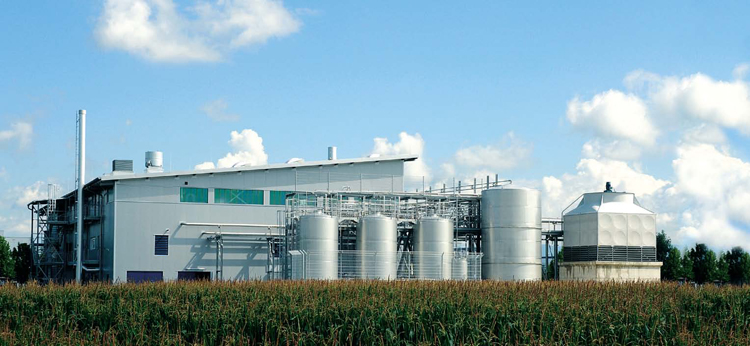 |
|
In July 2012, Clariant opened a new sunliquid® demonstration plant in Straubing, Germany, which verified the technology’s viability on an industrial scale |
It will be possible for the chemical industry to meet sustainability goals and yet be competitive?
Increasing demand, national security, depleting resources as well as global warming and the extensive climate and energy goals by governments can only be met if we also look for solutions in the field of biotechnology. A real change requires sophisticated biotechnological processes such as sunliquid® with corresponding production capacities. These have yet to be built, which is why new innovative or advanced biobased products like cellulosic ethanol are still more expensive than conventional production methods during its launch phase. First of its kind technologies always have the challenge to compete with long established industries.
We already see a number of green chemicals entering the market. A strong learning curve is expected for new technologies, as we have seen in the past for others and highly competitive technologies will succeed in the market.
The sunliquid® process developed by Clariant meets all the requirements of a technically and economically efficient, innovative process for converting agricultural residues into climate-friendly biofuels and biochemicals. Using process-integrated enzyme production, optimized enzymes, simultaneous conversion of cellulose and hemicellulose into ethanol and an energy-efficient process design, it has been possible to overcome technological challenges and sufficiently reduce production costs in order to arrive at a commercially viable basis.
European bioeconomy stakeholders complain of a lack of regulatory stability in Europe and move investments to other countries. From your point of view, what should the EU do to create a more favorable environment for industrial investments in the bioeconomy?
As we have seen in the fuels business, government support can help market entry and establishment of a new technology until it has reached competitiveness after a few years.
A high increase in production will be driven by the combination of the biofuel policy, customer demand, the reduction of production costs, and the increase in oil prices.
To ensure the transition from a fossil economy to a bioeconomy we need to bridge the gap between research and market. Besides support for the implementation of innovative and sustainable production processes and reference plants to demonstrate competitiveness, we need a stable and investment friendly political framework. E.g. in the field of biofuels we expect from policy makers a clear commitment to biofuels of the second generation. We are specifically referring to a binding sub-mandate for advanced biofuels under European legislation and a consequent implementation of the European Commission’s proposal for avoiding indirect land-use change (iLUC) by the support of biofuels made from lignocellulosic biomass and its differentiation from biofuels made from food. In addition the current admissible blending cap of ethanol is at 10% and the way for an E20 specification still has to be cleared. The fuel quality directive has to be adapted and the technical implementation within the European standard setting body has to be promoted. Long-term planning reliability and investor’s security is essential to bring innovative technology onto the market and make the transition to a more biobased and sustainable economy in Europe.



